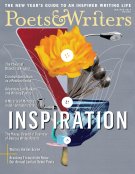Literary journals come and go, and once they go, they almost never come back. But December, a magazine founded in 1958 by students at the Iowa Writers’ Workshop that published early work by a generation of important writers including Donald Justice, Philip Levine, Joyce Carol Oates, and Raymond Carver (including one of Carver’s first short stories, “Will You Please Be Quiet, Please?”), is being resurrected after nearly three decades on the literary scrap heap.
The unexpected comeback of December—whose Revival Issue, released, naturally, in December, features 224 pages of poetry, prose, and visual art by new writers and artists as well as many of its original contributors, including Marvin Bell, Stephen Berg, Robert Mezey, Linda Pastan, Marge Piercy, and Robley Wilson—is largely the work of its new St. Louis–based editor, Gianna Jacobson.
“I feel very lucky to have this chance to bring it back,” says Jacobson, a former freelance journalist for national publications including the New York Times, BusinessWeek, Good Housekeeping, and Mademoiselle, who returned to school in midlife to earn an MFA in fiction writing from the University of Missouri in St. Louis. “I have a real sense of obligation to what I inherited, to December and to the people for whom it’s still such a meaningful name.”
Jacobson bought the rights to the title—along with about twenty boxes of back issues of the magazine and books published by its December Press imprint—from the estate of its longtime editor, Curt Johnson of Chicago, in November 2012. Johnson, who took over the journal in 1962, edited the semiannual magazine for a quarter of a century before discontinuing it in the mid-1980s to concentrate on the press, which he operated until his death in 2008. Jacobson connected with Johnson’s friend and executor, Craig Sautter, who, as Johnson requested before he died, had promised to find someone to carry on December’s legacy.
For Jacobson, buying December (for an amount she declined to reveal) was just the opportunity she’d been looking for. At the University of Missouri, she’d enjoyed working on the university’s literary journal, Natural Bridge, and had been seeking a similar experience while working on her first novel. “It was an exhilarating experience, finding the gems,” recalls Jacobson, who says she hates the term slush pile. “I loved to read, and didn’t mind reading everything to find something.”
With the December transaction completed, she set about reading all the back issues, which proved to her just how important the magazine had been. The May 1959 issue, for example, contained one of the earliest published poems by Levine, along with another poem written collaboratively by Mezey, Justice, and Berg. Another early issue featured a poem by James Wright, while a third contained an essay by a then-sitting United States Supreme Court justice, William O. Douglas. “I was astonished,” Jacobson says. “The magazine was just packed with early work by people who went on to have amazing careers.”
The new editor compiled a list of about a hundred and sixty original contributors who were still active and whose addresses she could find. Jacobson sent them letters inviting them to send work for the Revival Issue, expecting that perhaps fifteen to twenty would respond. “Lo and behold, I got eighty-six responses, all but two of which included new work,” she says. “In hindsight, I shouldn’t have been surprised, because writers are a very loyal and maybe a slightly sentimental group of people. A lot of them wrote in their letters about how important December had been to them early in their careers, how it motivated them to keep doing what they were doing.”
One of those writers was poet Grace Cavalieri, host of the long-running public-radio program The Poet and the Poem from the Library of Congress. “It was as if I’d just won the lottery,” Cavalieri says of the journal’s publication of some of her early work in 1973. “December was the classiest magazine that accepted my poems in the first few years of my career, and when Gianna said she was reviving it, it brought it all back in a rush. It was thrilling, in part because it’s so unusual. I’ve been on the scene for a very long time, and I haven’t seen anything quite like what she’s doing with December. The magazine is part of literary history, and she’s honoring its beginnings in such an impressive way.”
To help defray the cost of printing the Revival Issue, Jacobson secured a grant from the Kranzberg Family Foundation of St. Louis. She enlisted a group of prominent advisory editors, including some who were original December contributors and others who were not. (The list includes Cavalieri, Bell, Berg, and Piercy, along with Gary Belsky, Rita Mae Brown, Michael S. Harper, William Kittredge, Robert Nazarene, Steven Schreiner, and Sally Van Doren.) Jacobson also recruited Buzz Spector, dean of the College and Graduate School of Art at Washington University, as December’s visual art editor. (The Revival Issue features work by artists Peter Gourfain, an original December contributor, and Frank Magnotta.)
Going forward, Johnson intends to publish two issues per year and sponsor three annual contests in poetry, fiction, and nonfiction. She may also eventually revive December Press, but for now plans to concentrate on the journal. Submissions are currently being considered until February 1.
“In fiction and nonfiction, I’m looking for that exceptional balance of compelling language and a great story,” Jacobson says. “I’m not willing to take a beautifully written piece of work that doesn’t tell an interesting story or a compelling story that isn’t beautifully told. In poetry, I want work that’s challenging, difficult, or experimental, but also poems that are more accessible. I want people who aren’t necessarily reading poetry every day to find something in the magazine that they can appreciate as well.”
Kevin Nance is a contributing editor of Poets & Writers Magazine whose work also appears in the Washington Post, the Wall Street Journal, the Chicago Tribune, and elsewhere. Follow him on Twitter, @KevinNance1.








